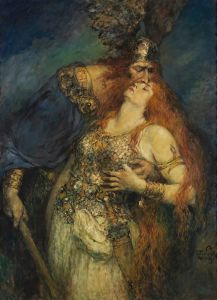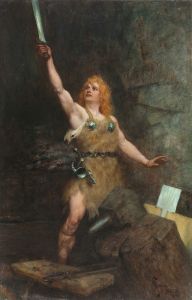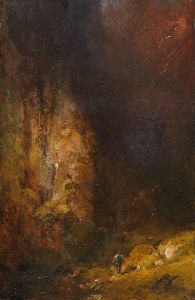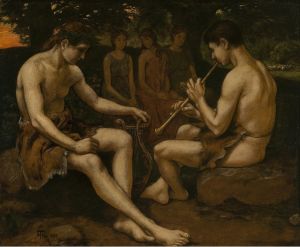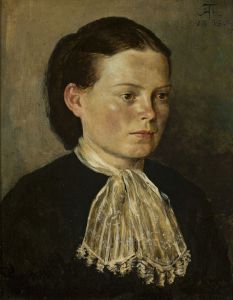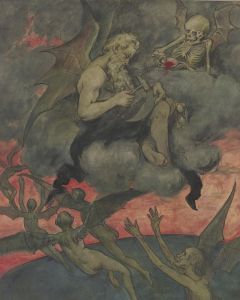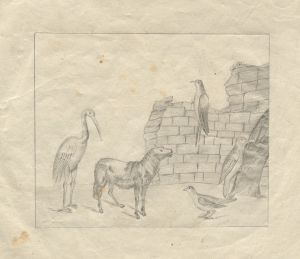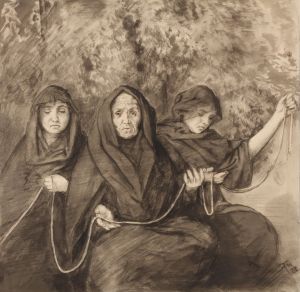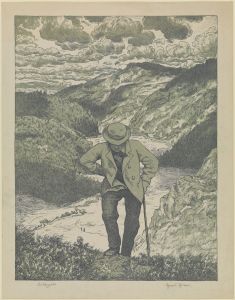
Wotan als Wanderer
A hand-painted replica of Hans Thoma’s masterpiece Wotan als Wanderer, meticulously crafted by professional artists to capture the true essence of the original. Each piece is created with museum-quality canvas and rare mineral pigments, carefully painted by experienced artists with delicate brushstrokes and rich, layered colors to perfectly recreate the texture of the original artwork. Unlike machine-printed reproductions, this hand-painted version brings the painting to life, infused with the artist’s emotions and skill in every stroke. Whether for personal collection or home decoration, it instantly elevates the artistic atmosphere of any space.
Hans Thoma was a German painter born on October 2, 1839, in Bernau, in the Black Forest region of Germany. He is known for his landscapes, portraits, and mythological themes, often drawing inspiration from German folklore and the natural beauty of his homeland. One of his notable works is "Wotan als Wanderer," which translates to "Wotan as Wanderer."
"Wotan als Wanderer" is a painting that depicts Wotan, a prominent figure in Germanic mythology. Wotan, also known as Odin in Norse mythology, is the chief of the gods, associated with wisdom, war, and death, as well as poetry and magic. In the context of Thoma's painting, Wotan is portrayed as a wanderer, a theme that resonates with the mythological stories where Wotan often travels the world in disguise, seeking knowledge and understanding.
Hans Thoma's depiction of Wotan reflects his interest in Germanic myths and legends, which were a significant source of inspiration for many artists during the 19th century. This period saw a revival of interest in national folklore and mythology, partly as a reaction to the rapid industrialization and social changes occurring in Europe. Artists like Thoma sought to reconnect with their cultural roots through their work.
The painting itself is characterized by Thoma's distinctive style, which combines elements of realism with a romanticized view of nature and myth. Thoma's use of color and light in "Wotan als Wanderer" is notable for its ability to convey the mystical and enigmatic nature of the god. The composition likely features Wotan in a natural setting, emphasizing his connection to the earth and the natural world, a common theme in Thoma's work.
Thoma's art often reflects a deep appreciation for the landscape of his native Black Forest, and this is evident in "Wotan als Wanderer." The painting may include elements such as dense forests, rolling hills, or serene skies, which are typical of Thoma's landscape backgrounds. These elements not only provide a setting for the mythological figure but also enhance the narrative of Wotan's journey and his role as a wanderer.
Hans Thoma's work, including "Wotan als Wanderer," was well-received during his lifetime, and he became a prominent figure in the German art scene. He held various positions, including a professorship at the Academy of Fine Arts in Karlsruhe, and his influence extended to future generations of artists.
Today, Thoma's paintings are appreciated for their unique blend of realism and romanticism, as well as their exploration of Germanic myths and legends. "Wotan als Wanderer" remains an example of his ability to capture the essence of mythological figures while grounding them in the familiar and beloved landscapes of his homeland. The painting continues to be studied and admired for its artistic and cultural significance, reflecting the enduring fascination with mythology and the natural world in art.





